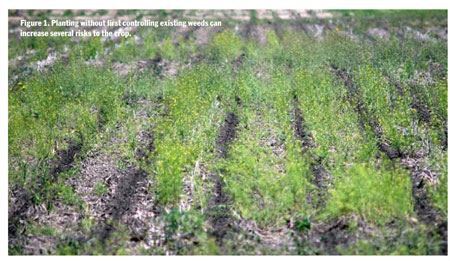Control Weeds Before Planting
URBANA, ILL.
Wet soil conditions have
caused delays in both
planting and efforts to
control existing weed vegetation.
Much of the existing
weed growth is comprised of
winter annual species, such
as common chickweed, henbit,
purple deadnettle, etc.,
but emergence of several summer annual
species also has begun. The growth of all
species has accelerated with warmer temperatures
and abundant soil moisture. Several
species of winter annuals are flowering and
could produce viable seed before they are controlled
with either tillage or herbicides. Much effort
will be directed toward planting when soil
conditions become conducive, and some may
elect to plant first and attempt to control existing
vegetation sometime afterward (Figure 1).
This practice introduces a large amount of uncertainty
and risk. Much uncertainty lies in
whether or not weather and soil conditions will
allow for the application of herbicides to control
existing vegetation before the crop emerges. The
risk of crop establishment problems and yield
loss increases if the crop emerges in a dense
stand of large weeds. We recommend that existing
weed vegetation be controlled before
planting by utilizing tillage, herbicides, or a
combination of tactics so the crop can become
established under weed-free conditions. Before
implementing any plan to control existing vegetation,
scouting to determine what species are
present and their densities can be time very well
spent.
Preplant tillage operations can effectively control
existing vegetation while preparing a
seedbed. However, as weeds become larger the
effectiveness of tillage to control weeds before
planting can be reduced. Dense stands of certain
winter annual weeds, such as common
chickweed, can “ball up” in a field cultivator.
Stems of larger common lambsquarters plants
bent over but not completely severed from the
roots during tillage may spring back upright in
a c-shaped or s-shaped configuration. Summer
annual weeds that survive preplant tillage are
often much more difficult to control with herbicides
applied after crop emergence. Reduced
weed control may also occur when fields are a
bit wet during the preplant tillage operation.
Soil disturbance may not be as extensive when
soils are retaining moisture, and clods are more
likely to be formed. Weeds are also more likely
to take root again after tillage when soil disturbance
is inadequate and soil moisture is abundant.

Figure 1. Planting without first controlling existing weeds can
increase several risks to the crop.
Be sure to make adjustments in the application
rates of herbicides used to control large
weeds in no-till situations. Glyphosate application
rates of 1.5 lb ae/acre or higher and combined
with other herbicides, such as 2,4-D, can
provide improved control of larger weeds. Include
AMS at 8.5–17 lb/100 gallons of spray solution,
and apply in sufficient carrier to ensure
good coverage of the dense vegetation. Be sure
to include a tankmix partner with glyphosate if
you suspect glyphosate-resistant marestail in
any fields, but be cautious about which herbicide
alternative you include with glyphosate.
Some herbicides that are more contact in activity
can sometimes antagonize glyphosate, especially
on large weeds. Δ
DR. AARON HAGER: Associate Professor, University
of Illinois